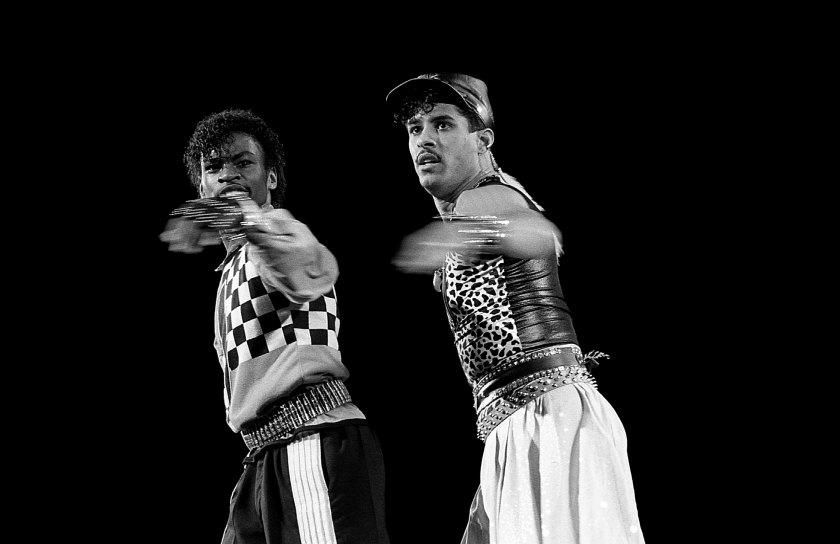Adolfo 'Shabba-Doo' Quiñones, whose moves changed the face of dance, dies at 65

- Oops!Something went wrong.Please try again later.
Hip-hop dancing pioneer Adolfo "Shabba-Doo" Quiñones once had a message for dance aficionados who felt that break-dancing was merely a trend, one less legitimate as an art form than classical dance.
"Ultimately people will realize it's a valid art form, on the same level as jazz or ballet," Quiñones told Newsweek in 1984 following the release of the low-budget hit "Breakin'," which featured him as a street dancer. "And it's a dance Americans should be proud of."
Quiñones, one of the most influential dancers of the hip-hop era and one of the innovators of the robotic dance style known as "locking," died Tuesday night at his Los Angeles home. He was 65.
Known as "Shabba-Doo," Quinones had a colorful career as a dancer, choreographer and actor. In addition to his starring roles in the popular "Breakin'" and its sequel "Breakin' 2: Electric Boogaloo," Quiñones choreographed for and worked with many top singers, including Frank Sinatra, Madonna, Lionel Richie and Chaka Khan.
He was also a founding member of the Original Lockers street dancing group and one of the Soul Train Gang dancers on the landmark R&B music series.
Quiñones' publicist Biff Warren told the Hollywood Reporter that the artist had undergone a COVID-19 test that had come out negative but "the next day he's dead. It opens up all kinds of questions."
The day before he died, the dancer posted on Instagram that he was "feeling sluggish from my cold" but was feeling better. A picture showed him in bed, flashing the peace sign and declaring he "was excited" and had "lots of catching up to do."
Chorographer/singer Toni Basil, who co-founded the Original Lockers, expressed "extreme sadness" about Quiñones' death on social media, while several other celebrities also paid tribute.
Ice-T tweeted: "I just lost ANOTHER close friend… SHABBA-DO, LA Dance Legend," adding a montage of Quiñones dancing. Sheila E called him "A great Hiphop dancer. We toured together w/ Lionel Richie 1983. Gosh, Rest In Peace my brother."
Dancing was a form of salvation for the dancer, who grew up in Chicago's Cabrini-Green housing project. Raised by a single mother, he said in a 2010 interview that he was a "bit of a hoodlum," hanging around with street gangs.
"The only thing I could do that was special was dancing," he said.
When the Chicago-based dance program "Soul Train" moved to Los Angeles in 1970 to establish a base for syndication, Quiñones and his family followed. He and other dancers started appearing on the show and they became a breakout feature as the Original Lockers, known for their kinetic dancing style.
"The Original Lockers changed the face of dance," he said in 2010. "'Soul Train' was that sort of fertile soil for us. We were able to like, work it all out on the show coming down the 'Soul Train' line."
"Soul Train" host and creator Don Cornelius had a major influence on young Quiñones. In a 2012 CNN interview, he said, "His influence on me was looking at him, being the spiffy dresser that he was. I mean, the guy was the epitome of cool, you know? I used to look at him and think, 'God, you know, I want to be like him. I want to be like that. I want to wear clothes like that.' He was just so cool, and he had swagger then before people knew it was swagger, you know, and so it had an influence on me as an artist, later on as a professional dancer."
He added, "If you've ever taken note of my career, you would see that I wore a lot of suits and things, and I tend to dress up. So there was a handful of people that I aspire to be when I grew up and that was — one was Cab Calloway. James Brown, we always want to be James Brown. And then Don Cornelius. You know, being a young Black kid, you know, you want to be like that. You want to be like the man. "
Leaving the Lockers for a solo career, Quiñones was summoned by Bette Midler and choreographer Kenny Ortega to appear in her Broadway show, "Divine Madness," starting in 1979. He was later called to choreograph Cannon Films' "Breakin'" — and wound up with one of the lead roles.
In the 1984 film, young ballet dancer Kelly (Lucinda Dickey) joins forces with street dancers Ozone (Quiñones) and Turbo (Michael "Boogaloo Shrimp" Chambers) to form a dance troupe.
In a promotional interview, Quiñones revealed that he had filmed most of "Breakin'" with a fractured wrist, but continued against the advice of his doctors. "It took me 12 years to get that movie role," he said. "I wasn't going to pass it up for a fractured wrist — no way."
In later years, Quiñones called himself "The Ghost of Break-Dance Past" as he worked on various projects, including directing videos, teaching dance to inner-city kids and opening a martial arts studio. In 1994, he confessed in Variety to visiting clubs in Orange County to check out the latest dances.
"It's like I wear hip-hop clothes but flannel underwear," he said with a chuckle.
This story originally appeared in Los Angeles Times.


